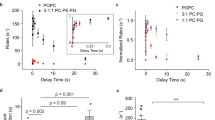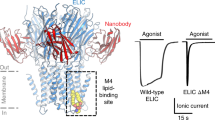Abstract
The effects of the peptide polycations salmon protamine (M r = 4332,z = + 21) and poly-l-lysine (M r ≅ 100,00,z ≅ + 775) on ion channels formed by synthetic alamethicin Alm-F30 (one negative charge), natural Alm-F50 (neutral) and phosphorylated Alm-F50 (two negative charges) reconstituted in planar lipid bilayers have been studied at the single channel level. It was observed that both polycations in micromolar concentrations transiently block ion permeation through the channels formed by each alamethicin analogue, although in case of the neutral Alm-F50 to a significantly lesser extent. Poly-l-lysine showed to be more effective than protamine in blocking these channels. If either polycation is present in the cis-compartment, blockade occurs only at cis positive membrane voltages. At constant polycation concentration, dwell times in the blocked state increase when salt concentration is lowered, and decrease at acidic pH with an apparent pK of 4.8. Mean lifetime of blockade events shortens when membrane voltage is increased, which suggests that both polycations may permeate through the oligomeric alamethicin channels if conductance levels are > 2. We suggest that blockade is caused by electrostatic binding of a single polycation molecule to the C-terminal channel mouth; in case of Alm-F30, Glu18 has to be considered as the putative binding site. Our results provide further evidence for the barrel-stave model and a parallel orientation of dipole monomers in the channel aggregate, the C-termini facing the membrane side with the more positive membrane potential.
Similar content being viewed by others
References
Aveyard R, Haydon DA (1973) An introduction to the principles of surface chemistry. Cambridge Chemistry Texts
Bannwarth W, Trzeciak A (1987) A simple and effective chemical phosphorylation procedure for biomolecules. Helv Chim Acta 70:175–186
Baumann G, Mueller P (1974) A molecular model of membrane excitability. J Supramol Struct 2:538–557
Bezrukov SM, Vodyanoy I (1993) Probing alamethicin channels with water-soluble polymers. Biophys J 64:16–25
Boheim G (1974) Statistical analysis of alamethicin in a lipid membrane. J Membr Biol 19:277–303
Boheim G, Kolb HA (1978) Analysis of the multi-pore system of alamethicin in a lipid membrane. I. Voltage jump current relaxation measurements. J Membr Biol 38:99–150
Boheim G, Hanke W, Jung G (1983) Alamethicin pore formation: voltage-dependent flip-flop of α-helix dipoles. Biophys Struct Mech 9:181–191
Boheim G, Gelfert S, Jung G, Menestrina G (1987) α-helical ion channels reconstituted into planar bilayers. In: Yagi K, Pullman B (eds) Ion transport through membranes. Academic Press, London New York
Eisenberg M, Hall J, Mead CA (1973) The nature of voltage-dependent conductance induced by alamethicin in black lipid membranes. J Membr Biol 14:143–176
Esposito G, Carver JA, Boyd J, Campbell ID (1987) High resolution1H-NMR study of the solution structure of alamethicin. Biochemistry 26:1043–1050
Eyring H, Lumry R, Woodbury JW (1949) Some application of modern rate theory to physiological systems. Record Chem Progr 10:100–114
Fox RO, Richards FM (1982) A voltage-gated ion channel model inferred from the crystal structure of alamethicin at 1.5 Å resolution. Nature 300:325–330
Gatewood JM, Schroth GP, Schmid CW, Bradbury EM (1990) Zinc-induced secondary structure transitions in human sperm protamines. J Biol Chem 265:20667–20672
Gisin BF, Kobayashi S, Davis DG (1977) Synthesis of biologically active alamethicin. In: Goodman M, Meienhofer J (eds) Peptides: Proceedings of the Fifth Annual Peptide Symposium. Wiley, New York
Gordon LGM, Haydon DA (1972) The unit conductance channel of alamethicin. Biochim Biophys Acta 225:1014–1018
Hanke W, Boheim G (1980) The lowest conductance of the alamethicin pore. Biochim Biophys Acta 596:456–462
Hol WGJ, van Duinen PT, Berendsen JHC (1978) The α-helix dipole and the properties of proteins. Nature 273:443–446
Irmscher G, Jung G (1977) Die hämolytischen Eigenschaften der membranmodifizierenden Peptidantibiotika Alamethicin, Suzukacillin und Trichotoxin. Eur J Biochem 80:165–174
Jung G, Dubischar N, Leibfritz D (1975) Solvent and temperature induced conformational changes of alamethicin, a13C NMR and circular dichroism study. Eur J Biochem 54:395–409
Kolb HA, Boheim G (1978) Analysis of the multi-pore system of alamethicin in a lipid membrane. II. Autocorrelation analysis and power spectral density. J Membr Biol 38:161–191
McLaughlin SA (1977) Electrostatic potentials at membrane-solution interfaces. Curr Top Membr Transp 9:71–144
Mueller P, Rudin D (1968) Action potentials induced in biomolecular lipid membranes. Nature 217:713–719
Roy G (1975) Properties of conductance induced in lecithin bilayer membranes by alamethicin. J Membr Biol 24:71–85
Schmitt H, Jung G (1985a) Total synthesis of the α-helical eicosapeptide antibiotic alamethicin. Liebigs Ann Chem 1985:321–344
Schmitt H, Jung G (1985 b)13C NMR spectroscopic control of the synthesis of alamethicin F30 and its segments. Liebigs Ann Chem 1985:345–364
Schwarz G, Savko P (1982) Structural and dipolar properties of the voltage dependent pore former alamethicin in octanol/dioxane. Biophys J 39:211–219
Walton A, Blackwell J (1973) Biopolymers. Academic Press, London New York
Woolley GA, Wallace BA (1992) Model ion channels: gramicidin and alamethicin. J Membr Biol 129:109–136
Author information
Authors and Affiliations
Rights and permissions
About this article
Cite this article
Rink, T., Bartel, H., Jung, G. et al. Effects of polycations on ion channels formed by neutral and negatively charged alamethicins. Eur Biophys J 23, 155–165 (1994). https://doi.org/10.1007/BF01007607
Received:
Accepted:
Issue Date:
DOI: https://doi.org/10.1007/BF01007607




